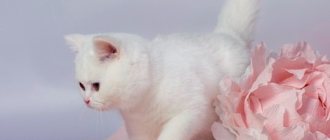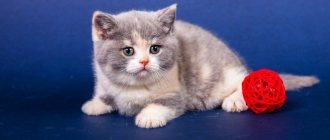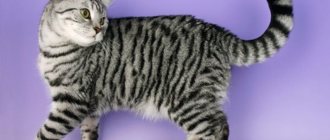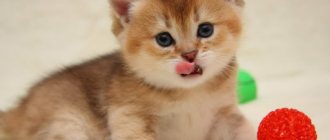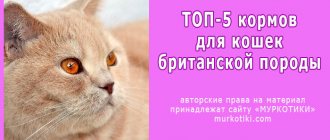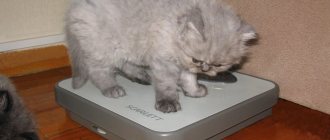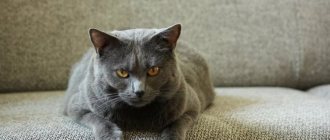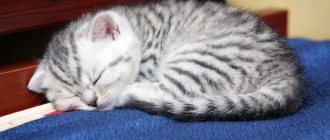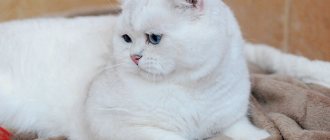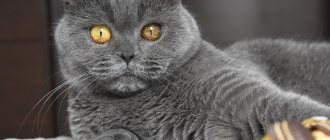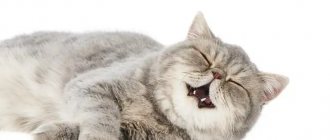British cats are famous for their variety of different coat and iris colors. Breeding representatives of the breed with different numbers of snow-white spots on their coats has become popular: bicolor cat, van, harlequin, tricolor. The main color of an animal's fur coat can be very different (black, chocolate, lilac, blue, etc.), and combinations of spots of various shapes are amazing.
BRITISH CATS WITH WHITE: TYPES OF COLOR
British cats with white in the color coding are supplemented by the number 01 - van, 02 - harlequin, 03 - bicolor - this is the relationship between the white color in the color and its quantity. There are the following types of colors with white spotting:
- bicolor/van/harlequin classic;
- tortoiseshell tricolors (calico);
- bicolor/van/harlequin/tricolor tabby;
- bicolor/van/harlequin/smoky tricolors;
- bicolor/van/harlequin/tricolor color-point;
- mixed colors (bicolor tortoiseshell shaded, bicolor color-point veiled, etc.).
The eye color of the British in color with white is always golden (yellow).
PHOTO GALLERY WITH DIFFERENT COLOR OPTIONS WITH WHITE
| Photo: British cat black and white - black harlequin (black harlequin) BRI n 02 | British chocolate bicolor BRI b 03 | British kitten blue bicolor BRI a 03 |
| Photo: British kitten lilac bicolor BRI from 03 | Photo: British cat cinnamon bicolor BRI o 03 |
|
| Photo: British red harlequin BRI d 02 | Photo: British cream bicolor BRI e 03 | Photo: British black and white – British kitten black van BRI n 01 |
| Photo: British black silver tabby bicolor Bri ns 22 03 |
| British tricolor cat - black and red tortoiseshell harlequin with white BRI f 02 |
| Photo: British cat lilac harlequin BRI d 02 | Photo: British cat blue van BRI a 01 | Photo: chocolate smoky bicolor BRI bs 03 |
| Photo: British kitten black and red tortoiseshell marbled bicolor BRI f 22 03 | Photo: British chocolate smoky color-point bicolor BRI bs 04 33 | Photo: British cinnamon color-point bicolor BRI o 04 33 |
COLOR OF BRITISH CAT BICOLOR (color code 03)
A British bicolor cat should be covered in white from 1/3 to 1/2 of the animal's color. The white color should be present from the British head in the form of a regular triangle, which begins on the forehead and diverges in both directions, touching the inner corners of the eyes. The collar and chest, the inside of the paws, and the belly should be white. The main color must be present on the head and back. The tail must be colored. There should be no white hairs in the main color (black, blue, lilac, etc.) - in this case, the color is rejected. The main color and white color must be clearly distinguished. The white spots are quite large, evenly distributed throughout the body. And, what is important, the overall color should look quite harmonious.
It must be said that sometimes bicolor British dogs do not always maintain an even white triangle on the head. Some white shift is allowed, but with clear boundaries. At least one ear must be painted in the main color.
Blue color with white British cats. Blue bicolor British
COLOR OF BRITISH CAT HARLEQUIN (color code 02)
The British Harlequin is also evenly distributed in color. The white color of the Harlequin British cat fills the color of approximately 5/6 of the coat color, the rest is colored color. The colored part of the color is present on the head, front legs, back, and tail.
Head: at least one colored spot, at least one ear of the animal must be colored.
Forelegs: Not desirable, but may have a few small spots of color. Ideally, the paws should be white.
Back: There may be colored spots with clear boundaries, not too small.
Tail: Fully colored.
The neck, collar, chest and paws are white.
COLOR OF BRITISH CAT VAN (color code 01)
The color of the British has the maximum amount of white, there are only a few colored spots: on the head (ideally two). The tail is completely colored. The ears should remain white. It is not desirable on the back, but a few spots of colored color are allowed. And, like all cats of this color category, there must be clear boundaries. There should be no white hairs in the colored form.
Blue tortoiseshell and white British cats. Blue-cream bicolor (calico, tricolor) British
COLOR OF BRITISH CAT MITTED (color code 04)
The mitted color in British cats is considered a disadvantage and is not recognized as a standard. There is too little white color, usually up to 1/4 of the part, it stretches from the head, passes through the neck, collar, chest and colors the stomach. The paws, as a rule, are also white, like the “socks”.
COLOR OF THE BRITISH CAT TRICOLORE (various combinations 04/03/02/01)
The British tricolor cat is also called calico or tortoiseshell and white. In addition to white, there are two more colors in the color. Spots of different colors do not intersect or mix, but have clear boundaries. Thus, the color retains the shape of the mosaic in a three-color version. The color, like all tortoiseshells, can only be found in cats.
Lilac-cream tortoiseshell and white British cats. Blue bicolor British
Interesting photo
Handsome color point Walks only on his own territory
The main advantage is the rich wool
Very beautiful mask
Friendly pair of Ragdolls
BRITISH KITTENS BICOLOR, VAN, HARLEQUIN, TRICOLOR: GENETICS
British kittens with white (bicolor, van, harlequin, tricolor) can only be born to parents of this color (or at least from one of the parents). This color is dominant. If the parents are not carriers of this group, they will never give birth to a bicolor, van, harlequin, or tricolor kitten.
Important! For those who are engaged in breeding these spectacular elegant colors, it is important to understand that it is very desirable that both parents be white, because a kitten may be born mitted (not white enough), and this is rejected by breed standards.
British bicolor, van, harlequin, tricolor kittens are born with colored spots, over time the color becomes more saturated, and the edges of the other color even out and become clearer.
The S gene is responsible for this color .
Formula:
SS - dominant color with white. Producers with this formula will always produce only white kittens, regardless of the color of the second parent
Ss - color with white, carrier of a solid color. A pair of Ss+Ss can produce kittens with or without white.
ss - color without white. A pair of ss+ss can never produce a white kitten.
Character of two-color cats
A cat's temperament directly depends on its color. It is believed that black and white cats have an ideal character. This is due to the heredity of the strong character of dark-colored cats and the softness of light-colored beauties. The bicolor cat is revered by the English and Scots. They perceive a meeting with a handsome man of this color as a blessing. In addition, they are very popular in Russia. These animals are stress-resistant, assertive, but easy to communicate with. They feel great even without human interaction and are very smart. They always understand the owner’s mood.
If they see that the owner is busy, they will not pester him. They usually don’t hold a grudge against the owner; they won’t take revenge on a person for an insult. They have this property from white cats, as well as their calm disposition. They are distinguished by amazing obedience and imperturbable composure. These cats love to play. This quality is stronger in them than in white or black cats. They are quite independent. Unlike other cats, they will not get their way in any way. Their dignity and pride will not allow this.
These cats get along well with people. They are capable of causing tenderness even in an overly serious person, not counting flexible and kind people. This is due not only to their wayward character, but also to their ability to remain calm.
GALLERY OF PHOTOS OF BRITISH CATS, CATS, KITTENS OF COLOR BI-COLOR, HARLEQUIN, VAN, TRI-COLOR
Lilac color with white British cats. Lilac bicolor British
Red (fawn) color with white British cats. Red (fawn) bicolor British
| In our cattery you can “buy a real British kitten.” We have many different colors, we will help you choose and answer all your questions! |
Health, diseases, what causes people to die
Genetic characteristics that affect the muscles of an animal lead to a susceptibility to a number of diseases. It is transmitted hereditarily.
- Hypertrophic cardiomyopathy. With pathology, thickening of the walls of the heart muscle occurs, most often of the left ventricle. The right ventricle is rarely affected.
- Dilated cardiomyopathy. The cavity of the left ventricle, or both ventricles, expands, which disrupts their contractile function. As a result, congestion in the heart region, heart failure and thromboembolic syndrome develop.
- Restrictive cardiomyopathy. The walls of the ventricles of the heart turn out to be pathologically stretchable, which is why the organ stops working fully.
- Hip dysplasia. A congenital disease that disrupts the process of development and primary formation of the joint. Increases the risk of dislocation and subluxation, and as the disease progresses, it leads to problems with movement.
- Periodontitis. Inflammatory gum disease, which can be prevented by regular brushing of your pet's teeth.
When purchasing a kitten, it is worth seeing the medical record of its parents. If they are healthy, then the risk of your pet developing diseases is reduced.
It is better to comb with a furminator
Jean Paul Maas "Genetics for Dummies"
In his book, Jean Paul Maas told us about the genetic basis of “white” colors. The issue of judging cats of this color was also raised there. Now bicolors are a “fashionable” and quite numerous color in many breeds. How are cats of this color group judged at shows?
First of all, we need to understand what, strictly speaking, is the meaning of examination and judging? Based on the standard, the judge evaluates how well the cat meets that standard. The expert notes:
- standard: “the eyes are round” - the cat has round eyes - yes, they are round - corresponds to ... points
- standard: “massive body” – a cat’s – yes, massive…points
- standard: “copper eyes” - the cat has none, pale yellow - less points, etc.
The breeder (we assume that he knows the standard for his breed?) reads the description of the cat and understands that the eye color needs to be improved. Is it possible to achieve this? Yes - by choosing the right pair.
The judge points out those aspects of the cat that can be corrected in the offspring, those parameters that can be selected. If the tabby pattern is not clear enough, it means you need to breed with tabby. A cream cat has a “hot cream” color - do not breed with strong colors, but only with weakened ones, etc. When assessing and describing a bicolor, the expert must be guided by the standards of the system in which the exhibition is taking place: are there requirements for color symmetry, for example, are differently colored and blue eyes allowed, etc. Of course, there are certain distinctions between bicolor/harlequin/van. Old-timers of felinology remember how at the first Russian exhibitions marks were reduced for dark spots on the legs, for the white tip of the tail, for the “torn cloak.” And how many owners have their lives ruined by the notorious “triangle” on the face!
Different times have come, an understanding has come that there are characteristics of cats that cannot be influenced by selection, that is, by the correct selection of pairs. This means that there is no need to so scrupulously describe the requirements of the standard for the bicolor group: after all, by selecting pairs it is almost impossible to obtain kittens with one or another distribution of white spots.
What should judges do?
- type is more important than color: first of all, pay attention to the type of cat
- Determining the color option is sometimes quite difficult. It is not uncommon for a cat to be either bicolor or harlequin.
- color flaws will be: dark spots on the belly, poor coloring of the “colored” part, unclear “borders” between the colored part and the white part (although this rather depends on proper grooming)
- the requirements for “symmetry” of color must be set out in the standard - otherwise symmetry is optional
Sometimes bicolors have colored paw pads (not pink). The standards allow this.
Advantages and disadvantages
| pros | Minuses |
| Kindness and affection towards the owner | Intolerance of loneliness |
| Get along with other pets | The need to strictly adhere to proper feeding |
| Complete absence of aggression towards children | High risk of injury from any fall, even from very low heights |
| Quiet voice | Reduced pain threshold, due to which the cat can be accidentally injured by a child |
| No tendency to form tangles | Inadmissibility of free range |
Classic colors
Today there are about 200 different types of British wool colors. However, all this motley diversity is clearly regulated. There is a whole system of international norms and standards, gradation of color according to a point system. Specialists in the field of felinology evaluate each kitten submitted to them for examination and assign it a unique code, which is recorded in the animal’s pedigree.
The assessment is influenced by many different factors: general genetics, color compatibility of the couple, how closely related the parents are to each other. One color gene may predominate over another - this also affects the resulting offspring.
The main points on which the assessment is carried out:
- intensity of coat and undercoat color;
- presence or absence of a picture;
- the color of the eyes, pads on the paws, as well as the color of the tip of the kitten’s nose.
All the current color varieties of British cats can be divided into several main groups.
Solid colors. They are also called solid or solid. The main requirement for them is that the color must be uniform.
The following solid colors are considered classic.
Black. Cats of this color are quite rare, so they are highly valued on the market. Black wool is hard to the touch by standard and has a beautiful sheen. The animal must be black, without exception, from the pads of its paws to the tip of its nose. Some concessions can be made for eye color: in addition to the usual green, copper and golden shades are allowed. The purity of the breed also depends on the undercoat - its color must exactly match the color of the coat.
The paws and nose should be the color of the coat, the eyes are traditionally copper or orange.
Care
Caring for a pet will require a lot of time from the owner. Because of this, if you are not sure that it will be enough, you should choose a simpler breed. It is necessary to take care of your Ragdoll systematically, otherwise your pet may get sick.
Wool
Long and thick wool requires mandatory combing. Even if there is no tendency to form tangles, without this procedure it will lose its attractive appearance. Also, due to the fact that the falling hairs will linger, clinging to the growing ones, the cat will constantly leave hair around, clinging to clothes and upholstery. During the molting period, combing is carried out at least 3 times a week; the rest of the time, once every 7 days is enough. Your pet should be accustomed to the procedure from an early age.
Advice! Cats don't like slickers. Furminator combs are most suitable for grooming hair.
Rarely, a tangle may appear. It must be removed quickly, otherwise there is a risk of skin problems. If you cannot comb it, then you need to cut off the matted fur using small sharp scissors or a special tangle cutter tool.
Bathe your pet 2-3 times a year. It is not advisable to use flea shampoos; Ragdolls often have severe allergies to them. You should not wash your cat with human shampoos, even children’s shampoos. You need to purchase products for long-haired cats for your pet, preferably hypoallergenic.
Grooming doesn't end there. Dry it with a terry towel. Using a hairdryer is possible if the pet is not afraid of it. The device is set to gentle mode.
In the summer heat, it is permissible to trim your cat with a clipper to prevent overheating. By winter, new fur will grow, which will be no worse than the previous one.
If the scratching post installed for your cat is ineffective, it is recommended to trim the claws a couple of times a year with a special tool. This procedure is not required if you buy a normal scratching post.
While licking itself, a cat swallows a significant amount of hair. To remove it from the stomach, special pastes should be used.
Walks
Free walking of cats of this breed is strictly prohibited. Due to low muscle tone, any fall will cause your pet to be injured, as it will not be able to roll over in the air. Walking in the fresh air is beneficial for cats. You should walk your pet on a harness or in your arms. Ragdolls need to be leash trained from an early age.
What to feed
The cat's diet should be balanced and complete. If ready-made diets are used, then you should choose super premium food. Proteins in the diet should make up 40% of its volume.
Advice! The breeder from whom the kitten is purchased can advise you on what ready-made food is best to use for your pet at different ages.
The natural diet is prepared separately for the cat. These are not products from the owner's table. You can give Ragdoll:
- lean boiled meat;
- boiled eggs, preferably quail, 2 times a week - no more often;
- dairy products;
- boiled vegetables can be given daily;
- boiled sea fish every 7 days;
- porridge (buckwheat, rice and oatmeal) – it makes up up to 25% of the diet.
There must be water constantly. Change it at least once a day.
Adult cats need to receive 300 g of food per day, divided into 2-3 meals, and kittens - 120 g. Growing Ragdolls are fed up to 3 months 6 times a day, and from three months to 9 months - 4 times a day. Then they switch to the adult feeding regime.
It is best to purchase an automatic cat feeder, with which your pet will always be fed as many times a day as necessary, at the same time, and during your absence too. It also wouldn’t hurt to add a fountain drinker that will provide him with clean, filtered water.
When feeding naturally, it is necessary to additionally enrich the pet’s diet with vitamins and minerals.
It is necessary to constantly provide a clean tray for the cat with a special filler, otherwise she will arrange a toilet in any other place she likes. Currently there is a large selection of different trays and automatic toilets. If your cat doesn't like her litter box, then it might make sense to replace it with another one. If you don’t want to deal with the daily unpleasant routine, you can retrain your cat to go to the toilet on the toilet.
Is it worth starting
Ragdolls are unique cats that require proper care and special care from their owner. They are suitable for those who can provide their pet with complete safety from injury, taking into account its characteristics and the constant company of another animal or family member. This is an unusual cat, it will thank a person with devotion and tenderness, but on the condition that it is treated properly. Ragdoll should not be purchased as a toy for children, taking advantage of its peaceful nature. First of all, it is a living being with its own feelings and rights, which is important not to forget.
The British - who are they?
Britons are one of the most popular domestic cats in Europe. The breed went through a difficult development path before acquiring its modern appearance. Today they are large (the average weight of a cat is six kilograms), powerful and stocky animals with a large round head, expressive eyes and small ears. Particular attention is drawn to the luxurious fur with its huge variety of colors and patterns: the famous “plush” for short-haired ones and thick, fluffy for long-haired ones.
According to legend, the distant ancestors of modern Britons were brought to Foggy Albion about two thousand years ago by the Romans. It can be assumed that those cats were predominantly wild in color - tabby, but have since changed greatly, crossing with local stock and adapting to the cold climate.
